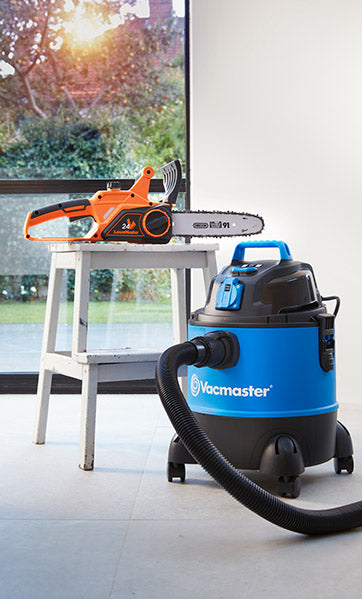-
Free Next Day Delivery
-
Buy Direct from the Makers
-
UK Customer Support
Workshop Vacuum Cleaners: What To Look For
3 Min Read
- Buying Guide
Share

When it comes to finding the best workshop vacuum, what really counts is how effective it is at extracting dust. Especially if you're engaging in woodworking activities that can generate large volumes of dust.
Dust extractors protect you from breathing in potentially harmful toxins by collecting as much dust as possible straight, from the source. Breathing in dust for a sustained period of time can cause health problems, so it's vital that you have good dust extraction in your workshop.
One of the most important features to consider when choosing your workshop dust extractor, is how it connects and powers the tools you most often use. For example, does it come with an adaptor that fits the various exhaust ports on your tools and can you automatically switch the vacuum on and off from the power switch on the tool (often referred to as Power Take Off )? If it does have PTO, what is the maximum wattage you can safely connect? Is that going to be enough for the tools you want to connect?
The Vacmaster Multi 20 PTO and Power 30 PTO vacuum cleaners are ideal for use as woodworking dust extractors. They each feature integrated power take off (PTO) sockets and come supplied with universal power tool adaptors.
How to use a PTO socket for dust extraction
Simply plug your power tool into the power take off socket on the head of the vacuum cleaner and connect the vacuum hose to the exhaust port of the tool with the adaptor provided, if necessary.
Set the switch to the PTO position on the vacuum (that’s position two on Vacmaster vacuum cleaners) and you're ready to go. The vacuum cleaner will start as soon as you switch the power tool on and will begin extracting dust straight away. The vacuum will also stop automatically after a couple of seconds of you switching off your power tool. The collects any remaining dust from the environment.
Workshops and sheds can become damp places, and the sawdust that gathers on the floor can in turn absorb this moisture. Regularly cleaning damp surfaces and floors would ordinarily clog filters that are supplied in regular household vacuum cleaners and so it isn’t advised using them for this purpose.
So, another handy feature to look out for when choosing a workshop vacuum is whether it can collect liquid as well as dry debris. All our Vacmaster dust extractors are also wet and dry vacuum cleaners, so they can be used for cleaning sludge, floods and drains etc. as well as dust and rubble.
Many wet and dry vacuum cleaners can also be used bagless but not all, so it’s worth checking the fine print if this is a consideration for you. Collecting wet and dry debris straight into the tank will benefit your purse or wallet, especially if you’re collecting large volumes of dust or rubble. Bear in mind, however, that you will have to clean the filters and tank more often. It’s also worth noting that using dust bags makes disposing of the dust easy and hygienic.
We would also always advise using a pre-filter if you’re regularly using your vacuum for collecting fine dust. The added protection you get from a pre-filter maintains the effectiveness of the main cartridge filter and therefore the overall suction performance of the vacuum cleaner.
Here’s 10% off our Vacmaster workshop vacs referred to in this blog.
Choose the model you want and then use discount code WORK10 to get 10% off your purchase.
|
Multi 20 PTO |
Power 30 PTO |
 |
 |
|
1250W motor |
1500W motor |
|
20L polymer tank |
30L stainless steel tank |
Please note: the workshop vacuum cleaners that we have recommended above are ideally suited for use in small workshops in the home or garage. We also have a range of heavy duty industrial dust extractors that would be more suitable for larger commercial workshops.
